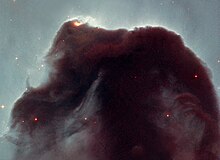Interstellar dust
The interstellar dust is that part of the cosmic dust that is part of the interstellar matter .
In the visual, interstellar dust is primarily noticeable through extinction , especially within the galactic disk of the Milky Way . In addition, interstellar dust is directly detectable in the infrared due to its temperature radiation .
properties
Size and shape
The dust particles have an average diameter of about 0.3 µm and are therefore microscopic. The exact distribution of the diameter of the dust particles is still unknown and can vary widely.
Furthermore, it is now assumed that interstellar dust particles deviate significantly from the idealized spherical shape and that their volume encloses a vacuum of up to 40 percent .
dynamics
The dynamics of growth (by addition of additional material) and destruction (by supernova - shock waves ) of the dust particles is still largely unknown. It has now been established that stardust only makes a very small contribution to interstellar dust. This means that it mainly arises directly in interstellar matter.
Chemical composition
The chemical composition is determined by determining the abundance of elements in the interstellar gas and comparing it with the abundance of elements in the sun . If certain elements are less abundant in gas than in the sun, they are most likely condensed in the dust. The main components of interstellar dust are:
- Silicates , here in particular pyroxene (Mg x Fe 1-x SiO 3 ) and olivines (Mg 2x Fe 2 (1-x) SiO 4 ).
- Carbon in the form of graphite , but not in the typical plane-parallel layering, but as a ball. Carbon may also occur in the form of fullerenes .
temperature
Typical dust temperatures are between 10 and 100 Kelvin . On the galactic scale one can distinguish two dust "populations":
- cold dust with temperatures of 10–20 Kelvin. Due to the low temperature, it is noticeable through emission in the difficult to access far infrared from approx. 100 µm. It dominates the mass balance and is usually very extensive in spiral galaxies , similar to neutral hydrogen .
- warm dust with temperatures above 30–100 Kelvin. It can be detected in the mid- infrared , for example with WISE , and is less diffuse. The strong UV radiation emitted by young, newly formed stars is responsible for its warming . Therefore it can be associated with star formation regions such as emission nebulae and cold molecular clouds .
See also
literature
- Genzel R & Cesarsky CJ: Extragalactic Results from the Infrared Space Observatory , Annual Review of Astronomy and Astrophysics 38: 761-814, 2000
- J. Binney & M. Merrifield: Galactic Astronomy (Princeton Series in Astrophysics) , 1998
- DCB Whittet: Dust in the Galactic Environment (Graduate Series in Astronomy)
- Mayo J. Greenberg: The cosmic dust connection. Kluwer, Dordrecht 1996, ISBN 0-7923-4365-4
- Gorden Videen: Optics of cosmic dust. Kluwer, Dordrecht 2002, ISBN 1-4020-0819-8
- Edmond Murad, Iwan P. Williams: Meteors in the earth's atmosphere - meteoroids and cosmic dust and their interactions with the earth's upper atmosphere. Cambridge Univ. Press, Cambridge 2002, ISBN 0-521-80431-0

